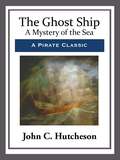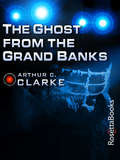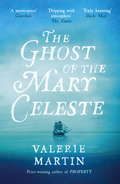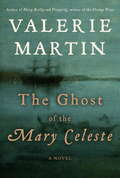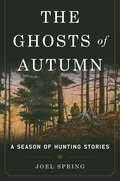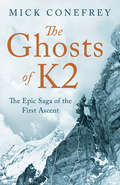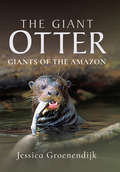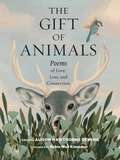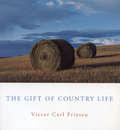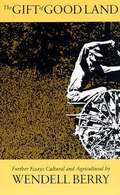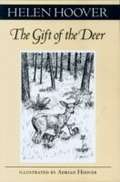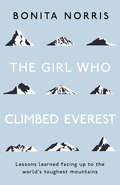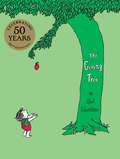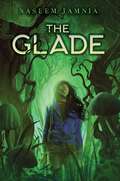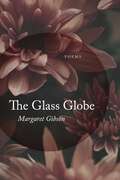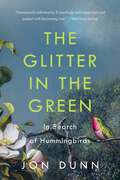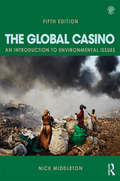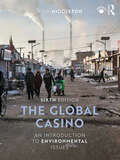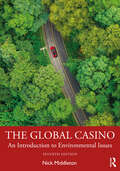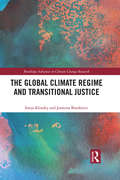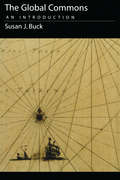- Table View
- List View
The Ghost Ship
by John C. HutchesonYoung Dick Haldane sets out on his first sea voyage aboard the S.S. Star of the North, from the deck Dick sees a Ghost Ship. A large fullrigged ship with white canvas sails all crimson from a last expiring gleam of the Sun's afterglow. The ship's sails were tattered and torn, with the ragged ends blowing out loose from the boltropes in the most untidy fashion, unkempt, uncared for! But when he tries to call this ghostly ship to the attention of the rest of the crew he discoveres that he alone can see it.
The Ghost from the Grand Banks (Arthur C. Clarke Collection)
by Arthur C. ClarkeIn this near-future sci-fi novel by the author of 2001: A Space Odyssey, two companies competing to raise the Titanic find mystery among the wreckage. Two years before the centennial anniversary of the Titanic&’s demise, two powerful corporations compete to recover the legendary vessel from the floor of the North Atlantic. With the wreckage split in two, each company—one British and one Japanese—plans to use its spectacular technology to raise one half of the famous ship. But what they find deep beneath the ocean&’s surface is more than they bargained for. Discovered among the Titanic&’s remains are six perfectly preserved bodies, including one of a beautiful woman who was not listed among the ship&’s original passengers. Who was she—and what was her secret? The mission to find out becomes all-consuming and, for some, deadly. This fast-paced tale combines a centuries-old mystery with modern suspense and Clarke&’s visionary imagination—here concerned with future technologies, ecological crises, and the mysteries of fractal mathematics.
The Ghost of the Mary Celeste (Vintage Contemporaries Ser.)
by Valerie MartinFrom the ORANGE PRIZE-winning author, an enthralling novel about an enduring mystery, an infamous mystic and Arthur Conan Doyle.
The Ghost of the Mary Celeste: A Novel (Vintage Contemporaries)
by Valerie MartinA captivating, atmospheric return to historical fiction that is every bit as convincing and engrossing as Martin's landmark Mary Reilly. In 1872 the American merchant vessel Mary Celeste was discovered adrift off the coast of Spain. Her cargo was intact and there was no sign of struggle, but the crew was gone. They were never found. This maritime mystery lies at the center of an intricate narrative branching through the highest levels of late-nineteenth-century literary society. While on a voyage to Africa, a rather hard-up and unproven young writer named Arthur Conan Doyle hears of the Mary Celeste and decides to write an outlandish short story about what took place. This story causes quite a sensation back in the United States, particularly between sought-after Philadelphia spiritualist medium Violet Petra and a rational-minded journalist named Phoebe Grant, who is seeking to expose Petra as a fraud. Then there is the family of the Mary Celeste's captain, a family linked to the sea for generations and marked repeatedly by tragedy. Each member of this ensemble cast holds a critical piece to the puzzle of the Mary Celeste. These three elements--a ship found sailing without a crew, a famous writer on the verge of enormous success, and the rise of an unorthodox and heretical religious fervor--converge in unexpected ways, in diaries, in letters, in safe harbors and rough seas. In a haunted, death-obsessed age, a ghost ship appearing in the mist is by turns a provocative mystery, an inspiration to creativity, and a tragic story of the disappearance of a family and of a bond between husband and wife that, for one moment, transcends the impenetrable barrier of death.
The Ghosts of Autumn: A Season of Hunting Stories
by Joel Spring"This is my cathedral. These are my meditations. I was raised Methodist, but this is my religion.”"The fields and woods and old orchards here are sacred ground. I feel the presence of my old friends. I am humbled in the face of the beauty of the place and experience the quiet only found in nature. The peace for which we all search envelops me. On my worst days I’ve never failed to find it here.”The Ghosts of Autumn joins Joel Spring for one brief season in the life of an avid outdoorsman. Stories of dogs and deer, friendship and adventure, heartache and triumph are set against a backdrop of the vivid colors of autumn. From the first few wisps of cool north wind in September, through the frigid mountain cold of a late December morning, the author treats you like a welcomed friend.Spring’s carefully crafted prose revisits the ghosts of hundreds of past hunts with good dogs and good friends will appeal not only to avid hunters and outdoorsmen but also anyone who appreciates fine writing about nature. Spend some time with Joel Spring and The Ghosts of Autumn.Skyhorse Publishing is proud to publish a broad range of books for hunters and firearms enthusiasts. We publish books about shotguns, rifles, handguns, target shooting, gun collecting, self-defense, archery, ammunition, knives, gunsmithing, gun repair, and wilderness survival. We publish books on deer hunting, big game hunting, small game hunting, wing shooting, turkey hunting, deer stands, duck blinds, bowhunting, wing shooting, hunting dogs, and more. While not every title we publish becomes a New York Times bestseller or a national bestseller, we are committed to publishing books on subjects that are sometimes overlooked by other publishers and to authors whose work might not otherwise find a home.
The Ghosts of K2
by Mick Conefrey"Most of us will never experience K2. Mick Conefrey leaves readers with both tremendous admiration for and an appreciation of the consequences for those who succeed in an adventure so physically, mentally, and emotionally taxing."- Kirkus Reviews At 28,251 ft, K2 might be almost 800 ft shorter than Everest, but it's a far harder climb. In this definitive account, Mick Conefrey grippingly describes the early attempts to reach the summit and provides a fascinating exploration of the first ascent's complex legacy. From the drug-addicted occultist Aleister Crowley to Achille Compagnoni and Lindo Lacedelli, the Italian duo who finally made it to the summit, The Ghosts of K2 charts how a slew of great men became fixated on this legendary mountain.Through exclusive interviews with surviving team members and their families, and unrivalled access to diaries and letters that have been archived around the world, Conefrey evokes the true atmosphere of the Savage Mountain and explores why it remains the 'mountaineer's mountain', despite a history steeped in controversy and death. Wrought with tension, and populated by tragic heroes and eccentric dreamers, The Ghosts of K2 is a masterpiece of mountaineering literature.
The Giant Otter: Giants of the Amazon
by Jessica Groenendijk&“The charisma of these huge, Amazonian &‘river people&’ burns through even the most factual descriptions, emphasized by an abundance of photographs.&” —BBC Wildlife The aptly named giant otter is exceptionally well adapted to life in rivers, lakes and wetlands in tropical South America. Known in Spanish as lobo del rio or &‘river wolf,&’ it can be as long as a human is tall and is the most social of the world&’s thirteen otter species. Each individual is identifiable from birth by its pale throat pattern, as unique as your fingerprint. Giant otters are top carnivores of the Amazon rainforest and have little to fear . . . except man. There are many reasons why scientists and tourists alike are fascinated by this charismatic species. Spend a day in the life of a close-knit giant otter family and you&’ll realize why. Learn about their diet and hunting techniques, marking and denning behavior, and breeding and cub-rearing strategies, including shared care of the youngest members. Become familiar with the complex life histories of individual otters over their 15-year lifespans. And accompany a young disperser during the trials and tribulations of a year spent looking for a mate and a home of its own. &“The descriptions of the otters, their habits and their homes along with tons of jaw dropping photographs, made me feel (almost) like I was there myself. Treat yourself to a book that will transport you to a place like nowhere else on earth, where you explore the wilds of the Amazon from your own garden.&” —Cayocosta 72 &“An intimate, educational and a dedicated love letter to the Giant Otter.&” —Queen of Geekdom
The Giants Go Camping
by Jane YolenFrom the author's website: The 1970's was a time of a great upsurge in children's publishing, and everyone was trying easy readers. This little book--and its prequel THE GIANTS FARM--were both my entry into that particular genre. The five giants live on Fe-Fi-Fo-Farm which is what I wanted to call our farm when we first moved here. (We ended up naming it Phoenix Farm, but at the urging of my children, I used the other name in a book!) Tomie's pictures manage to look like--Tomie! But the characters are really a metaphoric Yolen-Stemple family. And boy, did we love to go camping--all over New England mainly, but also down into West Virginia where David's family still lived. This book was a Jr. Literary Guild selection.
The Gift of Aloha (Fountas & Pinnell LLI Purple #Level T)
by Kate FosterHawaii At once, the word paints a picture in the mind's eye. And the people in that picture are almost certainly wearing colorful flower garlands.
The Gift of Animals: Poems of Love, Loss, and Connection
by Alison Hawthorne DemingThis unique collection of poems from diverse contemporary voices offers a range of perspectives on humans' complex relationship with animals, celebrating and bearing witness to the lives of animals both wild and domestic. Animals have long been a source of inspiration, sustenance, and companionship, and poems about and for animals are among the oldest traditions across human cultures. This collection of contemporary poems adds to this ancient lineage, celebrating animals for their beauty and intelligence; empathizing over their suffering; and hoping for their future, which is entwined with our own. The presence of an animal is a gift. The loss of an animal is a grief. To share such feelings through poetry is to create a community of caring for the creatures that accompany us on Earth. The Gift of Animals includes poems by some of today's most beloved poets, including Ellen Bass, Lucille Clifton, Michael Collier, Toi Derricotte, Rita Dove, Camille Dungy, Mark Doty, Nick Flynn, Jorie Graham, Joy Harjo, Terrance Hayes, Arthur Sze, Yusef Komunyakaa, Ada Limón, Aimee Nezhukumatathil, Craig Santos Perez, Paisley Rekdal, and more.
The Gift of Country Life
by Victor Carl FriesenMemories of farming in the 1940s conjure up images of horse-drawn farm machinery, grain stooks in fields, hay meadows, free-range chickens and cords of wood strategically placed for fuelling the kitchen range – all before farming became the highly technical, big-time operation it is now. Author Victor Carl Friesen was born and raised on a quarter section farm in Saskatchewan and still owns the "home place." It is there he still goes to renew his inner being. His poems, grouped into seasonal activities or observations, celebrate the rural world. Written in traditional blank verse, his poetry includes activities of yesteryear, his personal connections to rural life and his reverence for nature. Nature, as Henry David Thoreau said, is "one and continuous." Victor Carl Friesen lives and writes in Rosthern, Saskatchewan, but photographs nature anywhere. The first recipient of the Alberta Book Award, he is the author of five books including The Year Is a Circle.
The Gift of Good Land: Further Essays Cultural and Agricultural
by Wendell BerryIn the twenty-four essays of this collection, Wendell Berry stresses the carefully modulated harmonics of indivisibility in culture and agriculture, the interdependence, the wholeness, the oneness, of man, animals, the land, the weather, and the family. To touch one, he shows, is to tamper with them all. Here he continues issues first raised in "The Unsettling of America"; the problems addressed there are still with us and the solutions no nearer to hand, Mr. Berry writes of his journeys to the highlands of Peru, the deserts of southern Arizona, and the Amish country to study traditional agricultural practices. He writes of homesteading, tools and their uses, horses and tractors, family work, land reclamation, diversified land use. In the title essay Mr. Berry draws parallels between the Christian notion of stewardship and the Buddhist doctrine of "right livelihood." He develops the compelling argument that the "gift" of good land has strings attached: the recipient has it only as long as he practices responsible stewardship.
The Gift of the Deer
by Helen HooverOn Christmas Eve an emaciated deer stumbled into Helen Hoover's yard in remote northern Minnesota. She nursed the buck back to health, embarking on a four year journey where she and her artist husband shared their lives with a heard of wild deer in a remote wilderness setting.
The Girl Who Climbed Everest: Lessons learned facing up to the world's toughest mountains
by Bonita Norris'What I've learned from climbing mountains is that we can push ourselves far beyond what we think we are capable of, and it's outside of our comfort zones that the most amazing things happen.'What drives us to go to our limits and beyond? What does it take to make dreams come true over all else? And how can you turn fear into courage? From Everest to K2, The Girl Who Climbed Everest is the story of Bonita Norris' journey undertaking the world's toughest and most dangerous expeditions. Once an anxious teenager with an eating disorder it was the discovery of a passion for climbing that inspired Bonita to change her life. Drawing on her experiences to capture the agonies - both mental and physical - and joys of her incredible feats Bonita also imparts the lessons learned encouraging you to harness greater self-belief.The Girl Who Climbed Everest is an honest exploration of everything Bonita has learnt from climbing. Life lessons about ambition, values, risk, happiness, the courage to fail, and what's ultimately important. An indispensable and important book for anyone who has ever doubted their potential or put limits on themselves - whatever challenge you face or ambitions you want to achieve, The Girl Who Climbed Everest will inspire you to take action and live life more fearlessly.
The Girl Who Climbed Everest: Lessons learned facing up to the world's toughest mountains
by Bonita Norris'What I've learned from climbing mountains is that we can push ourselves far beyond what we think we are capable of, and it's outside of our comfort zones that the most amazing things happen.'What drives us to go to our limits and beyond? What does it take to make dreams come true over all else? And how can you turn fear into courage? From Everest to K2, The Girl Who Climbed Everest is the story of Bonita Norris' journey undertaking the world's toughest and most dangerous expeditions. Once an anxious teenager with an eating disorder it was the discovery of a passion for climbing that inspired Bonita to change her life. Drawing on her experiences to capture the agonies - both mental and physical - and joys of her incredible feats Bonita also imparts the lessons learned encouraging you to harness greater self-belief.The Girl Who Climbed Everest is an honest exploration of everything Bonita has learnt from climbing. Life lessons about ambition, values, risk, happiness, the courage to fail, and what's ultimately important. An indispensable and important book for anyone who has ever doubted their potential or put limits on themselves - whatever challenge you face or ambitions you want to achieve, The Girl Who Climbed Everest will inspire you to take action and live life more fearlessly.
The Giving Tree
by Shel SilversteinAs The Giving Tree turns fifty, this timeless classic is available for the first time ever in ebook format. This digital edition allows young readers and lifelong fans to continue the legacy and love of a classic that will now reach an even wider audience."Once there was a tree...and she loved a little boy."So begins a story of unforgettable perception, beautifully written and illustrated by the gifted and versatile Shel Silverstein. This moving parable for all ages offers a touching interpretation of the gift of giving and a serene acceptance of another's capacity to love in return.Every day the boy would come to the tree to eat her apples, swing from her branches, or slide down her trunk...and the tree was happy. But as the boy grew older he began to want more from the tree, and the tree gave and gave and gave. This is a tender story, touched with sadness, aglow with consolation.Shel Silverstein's incomparable career as a bestselling children's book author and illustrator began with Lafcadio, the Lion Who Shot Back. He is also the creator of picture books including A Giraffe and a Half, Who Wants a Cheap Rhinoceros?, The Missing Piece, The Missing Piece Meets the Big O, and the perennial favorite The Giving Tree, and of classic poetry collections such as Where the Sidewalk Ends, A Light in the Attic, Falling Up, Every Thing On It, Don't Bump the Glump!, and Runny Babbit.And don't miss the other Shel Silverstein ebooks, Where the Sidewalk Ends and A Light in the Attic!
The Glade
by Naseem JamniaEllen Oh&’s Spirit Hunters meets Katherine Arden&’s Small Spaces in this middle grade supernatural mystery following a girl whose discovery of a magical clearing near her summer camp ends up putting her best friend in danger.Pina&’s first trip to summer camp is a chance to escape her overbearing parents and finally go on an adventure with her best friend, Jo. But Camp Clear Skies hides a secret: a clearing in the deep woods the older kids call &“the Glade.&” After falling asleep here, Pina and Jo are able to enter one another&’s dreams, transforming into superheroes and knights in shining armor, fighting back their nightmares in epic adventures. At first, the friends think they&’ve discovered a secret more exciting than any video game—until Pina&’s nightmares start leaking out into waking life. Worse, something seems to have followed them back from those dreams…and whatever it is, it&’s taking over Jo. Jo has always been the superhero in their friendship, but Pina can&’t just abandon them to their fate. To save her friend, Pina journeys deeper into the Glade than she ever has before, facing the worst of her own fears and Jo&’s. There, she must confront the consciousness trying to steal her friend&’s body and learn what happened twenty years ago that shut down Camp Clear Skies and changed the Glade forever.
The Glass Globe: Poems
by Margaret GibsonWith The Glass Globe, celebrated poet Margaret Gibson completes a trilogy distinguished by its meditative focus on the author’s experience of her late husband’s Alzheimer’s disease. In this new collection, she blends elegies of personal bereavement with elegies for the earth during the ongoing global crisis wrought by climate change. Gibson’s poems personalize the vastness of climate catastrophe while simultaneously enlarging personal grief beyond the limits of self-absorption. A work of great compassion and vision, The Glass Globe is a necessary, heartbreaking book from one of our most compelling poets.
The Glitter in the Green: In Search of Hummingbirds
by Jon DunnAn acclaimed natural history writer follows the trail of the remarkable hummingbird all over the world. Hummingbirds are a glittering, sparkling collective of over three hundred wildly variable species. For centuries, they have been revered by indigenous Americans, coveted by European collectors, and admired worldwide for their unsurpassed metallic plumage and immense character. Yet they exist on a knife-edge, fighting for survival in boreal woodlands, dripping cloud forests, and subpolar islands. They are, perhaps, the ultimate embodiment of evolution's power to carve a niche for a delicate creature in even the harshest of places. Traveling the full length of the hummingbirds' range, from the cusp of the Arctic Circle to near-Antarctic islands, acclaimed nature writer Jon Dunn encounters birders, scientists, and storytellers in his quest to find these beguiling creatures, immersing us in the world of one of Earth's most charismatic bird families.
The Global Casino, Fifth Edition: An Introduction to Environmental Issues
by Nick MiddletonThe Global Casino is an introduction to environmental issues which deals both with the workings of the physical environment and the political, economic and social frameworks in which the issues occur. Using examples from all over the world, the book highlights the underlying causes behind environmental problems, the human actions which have made them issues, and the hopes for solutions. It is a book about the human impact on the environment and the ways in which the natural environment impacts human society. The fifth edition has been fully revised and updated throughout, with new case studies, figures, and online resources such as downloadable figures and tables from the text and multiple choice questions for students, accessible at: www.routledge.com/cw/middleton. New topics covered in extended boxed case studies include payment for environmental services, ocean acidification, biofuels in Brazil, waste reduction through industrial symbiosis, and the long-term impact of natural disasters on vulnerable groups. Other approaches and concepts covered for the first time in this new edition include traditional ecological knowledge, environmental justice, the ‘resource curse’, and urban biodiversity. Eighteen chapters on key issues follow three initial chapters which outline the background contexts of the physical and human environments and the concept of sustainable development. Each chapter provides historical context for key issues, outlines why they have arisen, and highlights areas of controversy and uncertainty to appraise how issues can be resolved both technically and in political and economic frameworks. Each chapter also contains an updated critical guide to further reading and websites, as well as discussion points and essay questions. The text can be read in its entirety or individual chapters adopted as standalone reading. The Global Casino is an essential resource for students of the environment, geography, earth sciences and development studies. It provides comprehensive and inspirational coverage of all the major global environmental issues of the day in a style that is clear and critical.
The Global Casino: An Introduction to Environmental Issues
by Nick MiddletonThe Global Casino is an introduction to environmental issues which deals both with the workings of the physical environment and with the political, economic and social frameworks in which the issues occur. Using examples from all over the world, the book highlights the underlying causes behind environmental problems, the human actions which have made them issues, and the hopes for solutions. It is a book about the human impact on the environment and the ways in which the natural environment impacts human society. The sixth edition has been fully revised and updated throughout, with new case studies, figures, and online resources including a complete lecture course for tutors and multiple-choice questions for students. New concepts and topics covered for the first time in this edition include the green economy, the forest transition model, marine microplastic pollution, urban disasters, decommissioning of big dams, and the start of the Anthropocene. Recent international initiatives covered include the Paris Agreement on climate change, the Aichi Biodiversity Targets, and the Sendai Framework for managing disaster risk. New case studies include Morocco’s Noor concentrated solar power plant, desert recovery in Kuwait, and river management on the Huang Ho. Eighteen chapters on key issues follow three initial chapters which outline the background contexts of the physical and human environments and the concept of sustainable development. Each chapter provides historical context for key issues, outlines why they have arisen, and highlights areas of controversy and uncertainty to appraise how issues can be resolved both technically and in political and economic frameworks. Each chapter also contains an updated critical guide to further reading – many of them open access – and websites, as well as discussion points and essay questions. The text can be read in its entirety or individual chapters adopted as standalone reading. This book is an essential resource for students of the environment, geography, earth sciences and development studies. It provides comprehensive and inspirational coverage of all the major global environmental issues of the day in a style that is clear and critical.
The Global Casino: An Introduction to Environmental Issues
by Nick MiddletonThe Global Casino is an introduction to environmental issues which deals both with the workings of the physical environment and the political, economic and social frameworks in which the issues occur. Using examples from all over the world, the book highlights the underlying causes behind environmental problems, the human actions which have made them issues and the hopes for solutions. It is a book about the human impact on the environment and the ways in which the natural environment impacts human society.The seventh edition has been fully revised and updated throughout, with new case studies, figures and online resources comprising a complete lecture course for tutors and multiple-choice questions for students. New concepts and topics covered for the first time in this edition include the blue economy, marine heatwaves, Africa’s Great Green Wall, rewilding, net-zero commitments, nature-based solutions, emerging contaminants in global rivers, green infrastructure in sustainable cities, initiatives promoting zero-emission vehicles, and zoonotic diseases (including the COVID-19 pandemic). New case studies include gender impact assessment of big dams in Laos and Vietnam, reducing food loss and waste, liming sugar maple trees in North America to counteract soil acidification and soil erosion and poverty in Rwanda. Eighteen chapters on key issues follow three initial chapters which outline the background contexts of the physical and human environments and the concept of sustainable development. Each chapter provides historical context for key issues, outlines why they have arisen and highlights areas of controversy and uncertainty to appraise how issues can be resolved both technically and in political and economic frameworks. Each chapter also contains an updated critical guide to further reading—most of them open access—and websites, talks and podcasts, as well as discussion points and essay questions. The text can be read in its entirety or individual chapters adopted as standalone reading.This book is an essential resource for students of the environment, geography, development studies and earth sciences. It provides comprehensive and inspirational coverage of all the major global environmental issues of the day in a style that is clear, concise and critical.
The Global Climate Regime and Transitional Justice (Routledge Advances in Climate Change Research)
by Jasmina Brankovic Sonja KlinskyGeopolitical changes combined with the increasing urgency of ambitious climate action have re-opened debates about justice and international climate policy. Mechanisms and insights from transitional justice have been used in over thirty countries across a range of conflicts at the interface of historical responsibility and imperatives for collective futures. However, lessons from transitional justice theory and practice have not been systematically explored in the climate context. The comparison gives rise to new ideas and strategies that help address climate change dilemmas. This book examines the potential of transitional justice insights to inform global climate governance. It lays out core structural similarities between current global climate governance tensions and transitional justice contexts. It explores how transitional justice approaches and mechanisms could be productively applied in the climate change context. These include responsibility mechanisms such as amnesties, legal accountability measures, and truth commissions, as well as reparations and institutional reform. The book then steps beyond reformist transitional justice practice to consider more transformative approaches, and uses this to explore a wider set of possibilities for the climate context. Each chapter presents one or more concrete proposals arrived at by using ideas from transitional justice and applying them to the justice tensions central to the global climate context. By combining these two fields the book provides a new framework through which to understand the challenges of addressing harms and strengthening collective climate action. This book will be of great interest to scholars and practitioners of climate change and transitional justice.
The Global Commons: An Introduction
by Elinor Ostrom Susan J. BuckVast areas of valuable resources unfettered by legal rights have, for centuries, been the central target of human exploitation and appropriation. The global commons -- Antarctica, the high seas and deep seabed minerals, the atmosphere, and space -- have remained exceptions only because access has been difficult or impossible, and the technology for successful extraction has been lacking. Now, technology has caught up with desire, and management regimes are needed to guide human use of these important resource domains.In The Global Commons, Susan Buck considers the history of human interactions with each of the global commons areas and provides a concise yet thorough account of the evolution of management regimes for each area. She explains historical underpinnings of international law, examines the stakeholders involved, and discusses current policy and problems associated with it.Buck applies key analytical concepts drawn from institutional analysis and regime theory to examine how legal and political concerns have affected the evolution of management regimes for the global commons. She presents in-depth case studies of each of the four regimes, outlining the historical evolution of the commons -- development of interest in exploiting the resource domain; conflicts among nations over the use of the commons; and efforts to design institutions to control access to the domains and to regulate their use -- and concluding with a description of the management regime that eventually emerged from the informal and formal negotiations.The Global Commons provides a clear, useful introduction to the subject that will be of interest to general readers as well as to students in international relations and international environmental law, and in environmental law and policy generally.
The Global Commons: An Introduction
by Susan J. BuckAntarctica, the high seas and deep seabed, the atmosphere, and space are increasingly accessible - and exploited - resource domains. Collectively known as the global commons, they represent a new and profound challenge for international law and institutions. In The Global Commons, Susan Buck considers the unique physical, legal, management, and policy problems associated with these areas. The book is a clear, useful introduction to the subject that will be of interest to general readers as well as to students in international relations, international law, and environmental law and policy.
